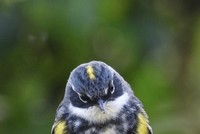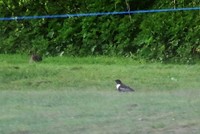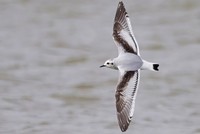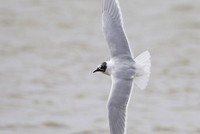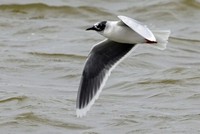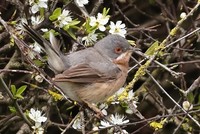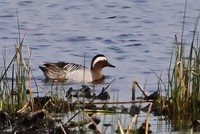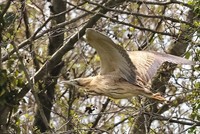Weekly round-up: 15 - 21 Jan 2014
Another good week, another damp week ~ at times ~ with some areas of the country struggling once again with the issue of impending floods in a particularly damp, wet winter.
The mish-mash of weather was still largely dominated by all that soggy Atlantic air, though east coast counties saw a bit of a chill descend as the review period drew to a close ~ more seasonal temperatures and even a touch of frost could be seen too.
Generally, the top billing this week was dominated by the (high-calibre) top-billed birds from last week, but there were a few newbies to keep 2014’s momentum running on high.
You go away for a few days and, almost immediately, get caught up in the crazy Polar Vortex that gripped the USA ~ from the mild’n’drizzly mid 50’s to some 25 below zero within 36 bone-chilling hours was something akin to a genuinely unique experience ~ followed soon after by watching from a far the surreal and sombre story of the fatal military helicopter crashing right in the middle of my beloved local patch….seeing Cley emblazoned across CNN, CBS and ABC was quite extraordinary, but for all the wrong reasons…
…add in Carnegie Hall, great gigs, lovely American gulls and geese, huge flocks of American Robins along the Jersey shore, topped off with a hefty bout of ‘flu, well, it has been a pretty weird few days.
2014 has, as has been mentioned here, there and everywhere, picked up in the same manic-mega fashion with rarities spread like avian flotsam and jetsam across our collective shores. More new birds came again this week, perhaps not of the same calibre as some species logged in the past three or four weeks, but of a suitably high standard to get the “oooo-nice” reaction when their names appeared on the pager.
Rarest bird of the week remained the American Coot that continued to reside and show to all comers at Loch Flemington (Highland) to 21st ~ this second record for the Scottish mainland (the first and only prior to this spending eight February days in Dumfries & Galloway in 2004) drew admirers for much of the week, despite the considerable distance involved in heading north for many.
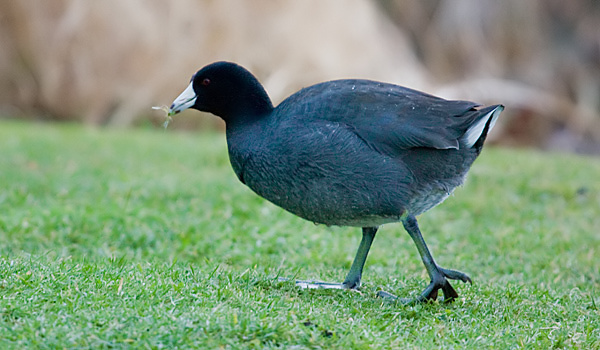
But it was a much-needed trek if you “don’t do Ireland” or have avoided splashing the cash for a jaunt to Shetland to see the returning bird of 2003-’05 or the Hebs bird of 2004 and 2005 too.
Yes, this jaunty vagrant remains crinkingly rare on the British mainland, whichever side of the borderline you want to look at ~ Scotland’s two now matches England’s two ~ the much-twitched Stodmarsh bird of April 1996 and the one-day first-summer in Cumbria on Crag Martin Day ~ April 17th 1999.
On the Welsh coast, on the beach at Rhossili Bay, the juvenile/first-winter Thayer’s Gull was noted again during 18th ~ the first sighting for a week (there was negative news on 12th). The bird was then seen again the following day on the southwest side of Burry Holms where some of the best images of the bird so far were obtained.
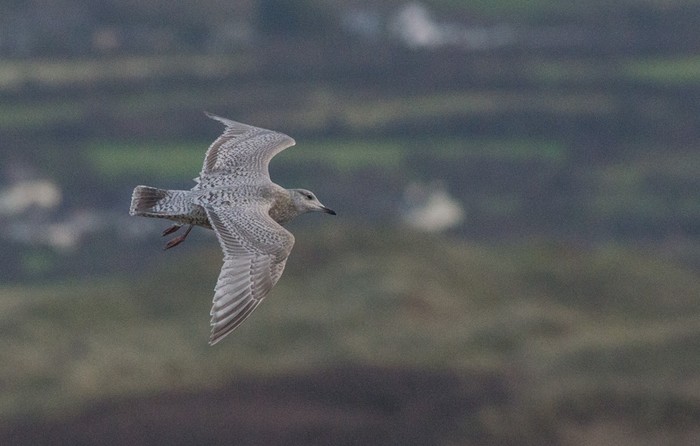
From those few photos available, this bird certainly fits in to the (ever-expanding) envelope of what a Thayer’s Gull can look like ~ a topic dealt with, albeit in the briefest manner here.
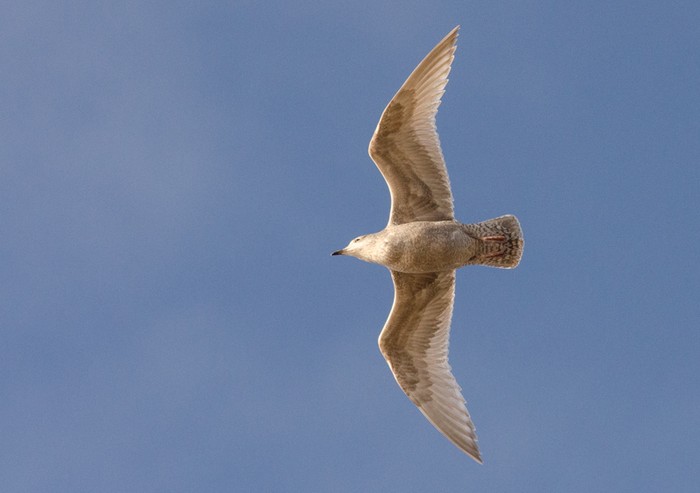
The two markedly different looking juvenile birds illustrated within that November review, one from Mayo in 2005 and the other from Galway in 2010 show the huge individual variations of what is considered to fit the Thayer’s bill at present~ and the current Welsh bird appears different again (not quite like the Lincolnshire juvenile, but not dissimilar to one or two other past accepted Irish birds) .
Can the current bird be deemed to be a genuine Thayer’s? What is, as has been asked here before, a genuine Thayer’s? That’s a tough one to answer…it does looks the part, but this one is edging towards the paler end of the (current) Thayer’s Gull scale.
The Nearctic vibe is clear but whether this is a provable pure bird or a hybrid smithsonianus x kumlieni (as a for instance, other hybrid options are available..) is up for debate. Again. Pure Thayer’s or not (and you’d have to argue that it is closer to the real deal end), it looks great and it was a superb find in the first place.
At #3 in the “popular Nearctic visitor” chart this week, a bird that, once again, behaved itself for much of the week was the American Buff-bellied Pipit that remained at Burton Marsh (Cheshire) ~ still there to 21st. Despite a half-century or so of records of this trixy-pipit, it does (as mentioned here before) remain a pretty tough species to catch up with on the mainland and this first for the Northwest has, rightly, deserved all the attention it has received.
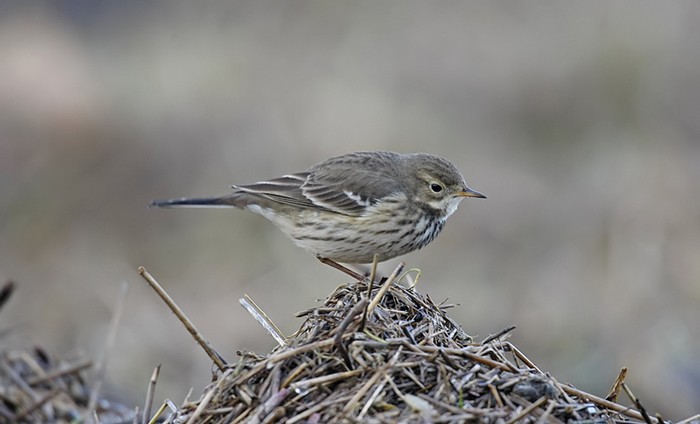
In Ireland, the delightful first-winter Ivory Gull was at the phenomenal Tacumshin until 21st while further up the east coast, Niall Keogh and Ricky Whelan found a fabulous winter adult Ross’s Gull alongside the North Bull Wall (Co. Dublin) on 15th, where it lingered to the following day ~ in what appears to be (after a brief glance through the books…) the first time ever that the two species have been in the country on the same date. An irresistible High Arctic Gulling double ~ I wonder, did anyone give it a go and head from one to the other? Two hours or so and around 100 miles apart, it would have been a hugely tempting duo…


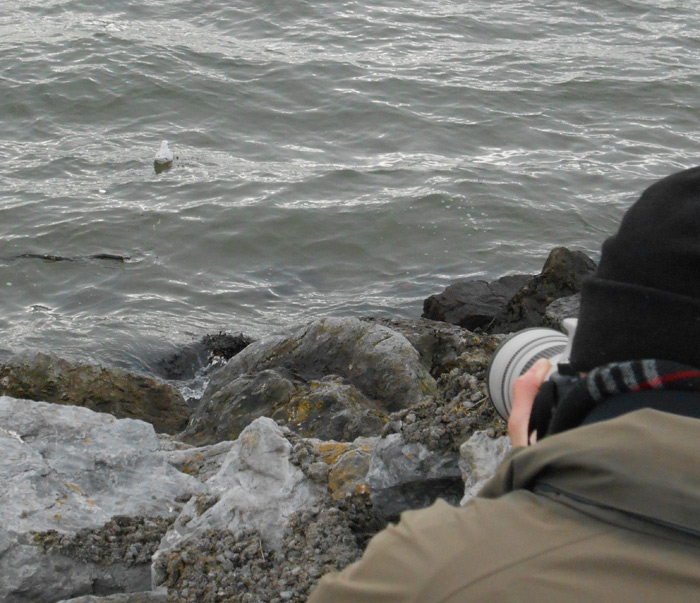
Give or take the odd pending record, it’s around 21 Ross’s to 18 Ivory’s in Ireland ~ Galway leads the way with the former with at least seven records while the latter sees Cork ahead with five accepted birds to date.
Arguably we’re leaving the best until last here ~ with the outstanding discovery of the north of Ireland’s first-ever Pacific Diver on Lough Fea (Co. Tyrone) on 19th.

Lough Fea is a relatively small area of water, certainly compared to the vast Lough Neagh that lies to the east, that nestles within the heart of inland Tyrone, surrounded by coniferous forest and mountain scenery ~ quite how a wayward Pacific Diver found its way there is anyone’s guess, but then again how did the first two British records manage to end up on the inland waters of North Yorkshire and Pembrokeshire? However it got there, it was in place ~ and admired by a fair few ~ to 21st.
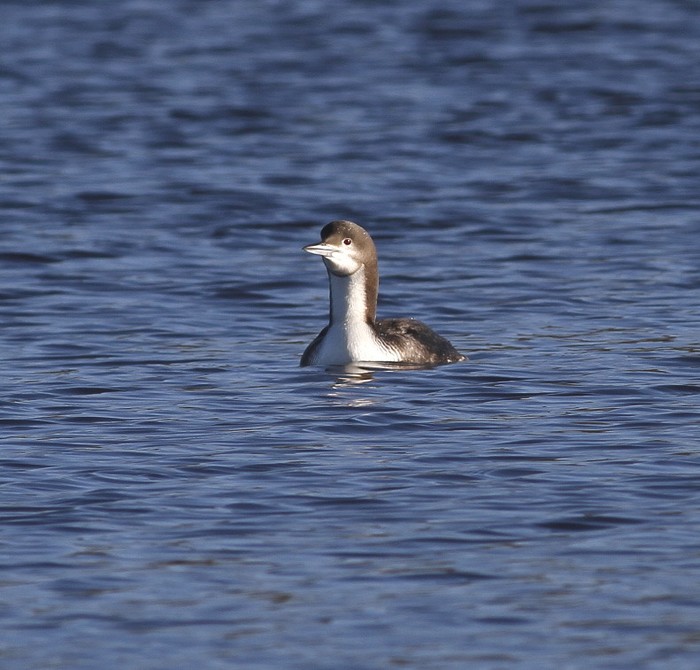
Ireland has so far recorded this teasing species in Galway and Clare (first seen in 2009, the bird was noted again in both 2010 and 2011) but this could be a new arrival, especially given the location. This week’s bird, along with the still-pending summer plumaged bird photographed on Shetland last spring, takes the total of individuals recorded to date to seven ~ the previously mentioned birds from North Yorkshire, Cornwall, Wales and the Irish west coast, along with an adult on the Severn Estuary in Gloucestershire in November 2009.
As a brief though hopefully pertinent aside, something about the past few weeks is certainly worthy of comment, something which the previous two species are at the heart of…

Portland (© Andrew Jordan). Thayer's Gull
Bury Holms (© Mark Hipkin). White-billed
Diver, Brixham (© Andrew Jordan). Ivory
Gull, Patrington, (© Stuart Piner). Pacific
Diver, Lough Fea (© Ronald Surgenor)
The remarkable push of Polar species, the High Arctic superstars has been the collective wonder of the winter of 2013-’14 ~ take a look at what we’ve been privy to since the first Ivory Gull appeared in Durham at the very end of November last year….
Most of the excitement generated came via that twitchable Brunnich’s Guillemot in Portland Harbour just after Christmas and that was, of course, one of two to appear (let’s not forget the fabulous find at Filey too) but rarer still were the two (or even three) Thayer’s Gulls that appeared in Donegal, Durham and Glamorgan, all since December 15th.
Those previously mentioned Ivory Gulls have wracked up a remarkable 10 or 11 to date (there may be some duplication but it is a total that still smashes all previous winters waaaaaaaay out of the park) and we’re up to three Ross’s Gulls too. The number of Kumlien’s Gulls has begun to rise too ~ last week Jon Dunn detailed at least 10 dotted around Britain and Ireland, that number almost doubling through the past seven days.
The super-showy White-billed Diver in Devon must also be a prime-suspect in being yet another species involved in this remarkable set of winter-warmers, and maybe the latest Irish Pacific Diver is too, but in many ways the absolute star at the top of the tree was Britain’s first record of Mandt’s Black Guillemot ~ seen inland in Cumbria at Talkin Tarn on December 20th-22nd.
Once regarded, back in the days of yore, as a separate species by the AOURC, this super looking snowy-headed bird would have posed an interesting insurance conundrum for some but we should marvel at the distance travelled by this distinctive form and wonder “what have we missed?”.
Given that most of these birds appeared three or four weeks ago, it feels as though if (and that’s a mighty big “if”) something even more stellar than the birds listed above did come along then maybe we’ve actually missed the boat already ~ it feels as though we were due another crazy Alcid or similar, indeed there’s the faintest whiff of similarity between the Swiss Long-billed Murrelet and the Cumbrian Mandt’s Black Guillemot record.
Interestingly, the flood of Snowy Owls along America’s Eastern Seaboard, arguably linked with the same push of birds that have made their way across the Atlantic to Britain and Ireland, failed to take off here (tho’ several made landfall elsewhere in northern Europe) but that was the only minus in a push of significant pluses.
Something extraordinary has happened this winter and at some point someone with far greater knowledge than that presented here will be able to extrapolate and interpret precisely what did happen across the past six to eight weeks, but the tally of birds listed above confirms just how startling the Polar influence has been…
Does the Musselburgh Scoter fit in there too….? Maybe it does, maybe it doesn’t. The first step to understanding that particular record is to be able to, safely, assign it to species, be it White-winged or Stejneger’s. Does it feel as immediate and obvious as the adult drake at Rossbeigh to you? Unless the bird reappears we may never know which mega-duck it was ~ either way, a great find.
Off the coast of south Devon, the popular White-billed Diver was still around Torbay for a few more days, present near the tip of Berry Head to 17th and then at nearby Broadsands the following day.
Single Pomarine Skuas were noted from the coasts of Suffolk (off Lowestoft) on 16th and East Yorkshire (from Flamborough Head) on 19th while half a dozen Balearic Shearwaters were shared between Devon (three there), Cornwall (two) and Kent (one) through the week while a Leach’s Storm-petrel in Shetland’s Bluemill Sound on 20th was something of a surprise.
At the start of the new review period, a single Little Auk was seen off Bants Carn, St. Mary’s (Scilly) on 15th (with two off the island on 19th) and this was followed by one near Portaferry (Co. Down) on 16th, at Abberton Reservoir (Essex) on 18th ~ it was later picked up dead, with another dead individual picked up on Achill Island in Mayo the same day ~ the same date also seeing two pass Bass Point (Cornwall).
Three lone Grey Phalaropes round things off here in a rather placid week at sea. One spent a few days (from 16th-19th) off Filey Brigg (North Yorkshire), another was at Peninerine, South Uist (Outer Hebrides) on 17th-18th and the final bird of the week was off Stag Rocks, Bamburgh (Northumberland) on 18th-19th.
/grey_phalarope_jan2014c.jpg)
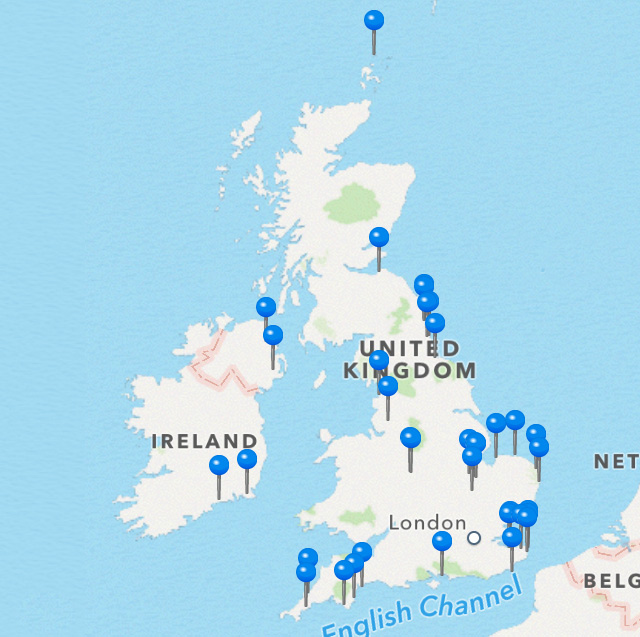
using our smartphone app BirdAlertPRO - try it for free here
After a spectacular 40+ tally for last week, numbers of Glossy Ibis fell by almost half over the past seven days, but there was still an impressive spread of records for all that (several sites seeing “no news” which may account for a drop in numbers too).
There were, for instance no records from the Outer Hebrides this week (they may have all gone of course) and Scotland’s only records came from Ballencrief (Lothian) on 16th and again on Westray (Orkney) on 17th. Dropping down to the northeast of England, two birds remained at Boldon Flats NR (Co. Durham) to 21st and singles were recorded at Cresswell Pond (Northumberland) ~ back again on 17th-18th ~ Lynemouth Flash, also in Northumberland, on 18th-21st and then Saltholme Pools RSPB (Cleveland) on 20th.
In the northwest, single Glossy Ibis were present at Pennington Green (Greater Manchester) from 15th-19th and Upper Thornham (Lancashire) on 16th-21st while the West Midlands boasted one still at Brownhills all week and another spent a few nights around Chasewater (Staffordshire) between 16th and 21st.
Cambridgeshire recorded a lone bird near Huntingdon on 18th, then at Eldernell on 19th-20th and Peakirk, also on 20th, while Suffolk’s sole representative remained at Oulton Broad to 19th, with Norfolk’s popular bird along the Glaven Valley, Cley showed daily to 21st (becoming a fine addition to my house list in the process…nice) while in the east of the county another flew over Martham Broad on 20th.
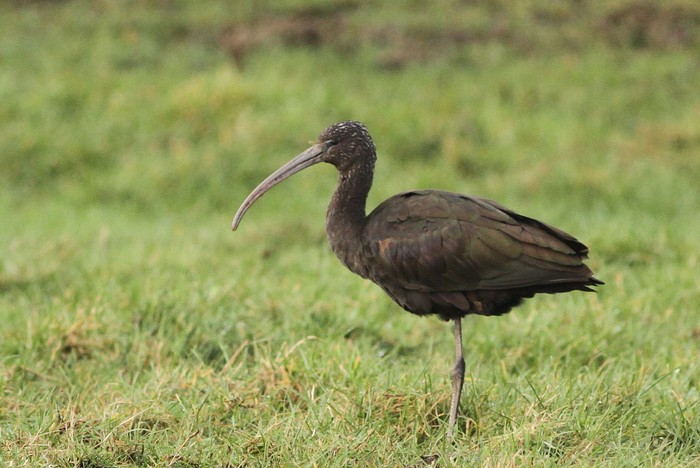
Down in Kent, two Glossy Ibis headed across Foreness Point, Margate on 15th and may well have been the same two that appeared at Sandwich Bay the following day, where they remained until 17th. A single was noted at Ramsgate, also on 17th, and two were seen at Harty Marshes and then Oare Marshes KWT on 18th-19th and in Hampshire, one flew over Farlington Marshes on 21st.
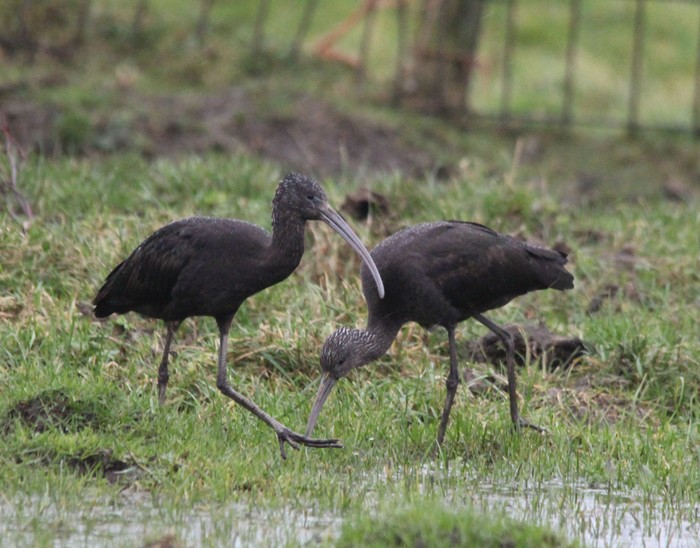
The southwest saw up to six birds on offer ~ two were still along the Otter Estuary, Budleigh Salterton (Devon) on 19th with singles elsewhere in the county at Aveton Gifford on 16th-20th and Clennon Valley on 21st while two more were seen in Cornwall ~ at Walmsley Sanctuary, near Wadebridge on 16th and still at Tregony to 19th.
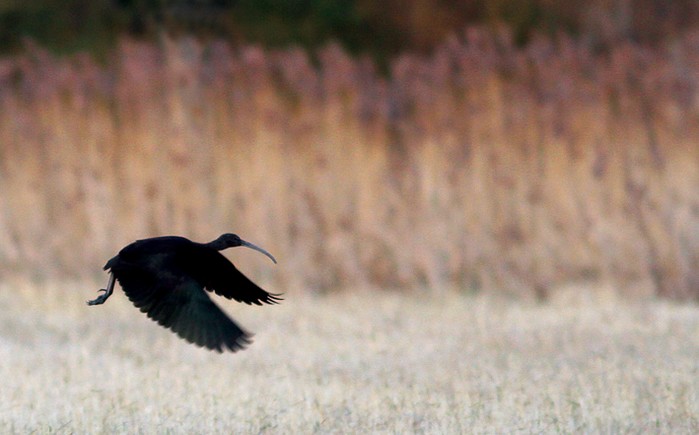
Seven Irish counties boasted the species last week, this week it was down to just three ~ one remained at the South Slob (Co. Wexford) to 20th and new were singles at Downpatrick Marsh (Co. Down) on 18th and at Larne Lough (Co. Antrim) on 19th-20th.
Great White Egrets stuck firm at around 22 or so for another week ~ Dungeness again out in front with six still there on 17th. At least eight sites in the northwest were graced by these most handsome of herons through the week, including four locations in Cheshire alone, including two at Parkgate on 17th. Two were again present at Ditchford (Northamptonshire) on 19th (three sites in the county scoring again this week) while there were two for the northeast and at least three in the southwest. In Wales, two were again at Llangorse Lake (Powys) on 19th and in Scotland, one was at Tarland (Aberdeenshire) on 20th (having appeared some six days previously).
It was “as you were” for the three Cattle Egrets ~ still present at Stoke Gabriel (Devon), Steeple Claydon (Buckinghamshire) and near Bunmahon (Co. Waterford) to the weekend, while at least 27 Spoonbills were counted in Poole Harbour, off Shipstall Point, on 20th. Elsewhere in the southwest, seven birds were at Isley Marsh RSPB (Devon) as the week ended, three remained at Wacker Quay (Cornwall) on 19th and two stayed on Samson (Scilly). Otherwise it was singles all round ~ one each for Cuckmere Haven (East Sussex) on 16th and Strangford Lough (Co. Down) and Dungarvan (Co. Waterford) on 18th.
The two wintering young Common Cranes remained around the Cheselbourne area of Dorset all week. Three were in the Norfolk Broads, near Brograve Farm, on 17th and eight were noted in Cambridgeshire, at Eldernell, on 19th. The following day saw two more reported from Angus, near Castleton of Essie.
In Mayo, on the Mullet, a Canada Goose was noted at Termoncarragh Lough on 17th, but not assigned to species.
Eight or nine Snow Geese were logged this week, as with several other groups, a slight drop in numbers compared to recent weeks, but one or two wintering birds weren’t reported, so it seems likely that we’re actually still in double figures.
Anyway…
Two blue Lesser Snow Geese moved from Clyde to Forth ~ appearing at Skinflats Lagoon RSPB on 19th while two Greater Snow Geese were still near Penrith (Cumbria) on 15th (with at least one still around on 19th) and another pair remained near Loch an Eilean, on South Uist (Outer Hebrides) to 18th at least ~ one of them bearing a metal ring.

Single white Snows were again noted at Loch of Strathbeg (Aberdeenshire) on 16th and again on 19th-20th (it or another was then at Rattray head on 21st) with Ireland’s only report coming from Carrahane Strand (Co. Kerry) on 17th-19th.
There were five Black Brants to report this week ~ the adult at Roa Island (Cumbria) was present to 18th and the first-winter remained at Kilnsea (East Yorkshire) to 20th at least. Dropping down to Norfolk, an adult was seen near Stiffkey on 19th and further south still, single adults lingered around Milford-on-Sea and Farlington Marshes (Hampshire) and the Exe Estuary to 20th at least. Back along the coast in Hampshire, the adult Red-breasted Goose was at Needs Ore Point NR on 18th.
In Ireland, the drake Black Duck was still on Sruhill Lough, Achill Island (Co. Mayo) on 19th and another was found on Termoncarragh Lough, also of course in Mayo, the same day. A drake Blue-winged Teal was found on Loch of Bosquoy, Mainland (Orkney) on 18th ~ perhaps the bird seen originally on North Ronaldsay at the end of last year?
Two of the week’s ten (or so) Green-winged Teals were present at Newgale (Pembrokeshire) on 19th while Orkney accounted for two more, one still on North Ronaldsay on 16th with another on the Mainland, at Tankerness, on 18th.
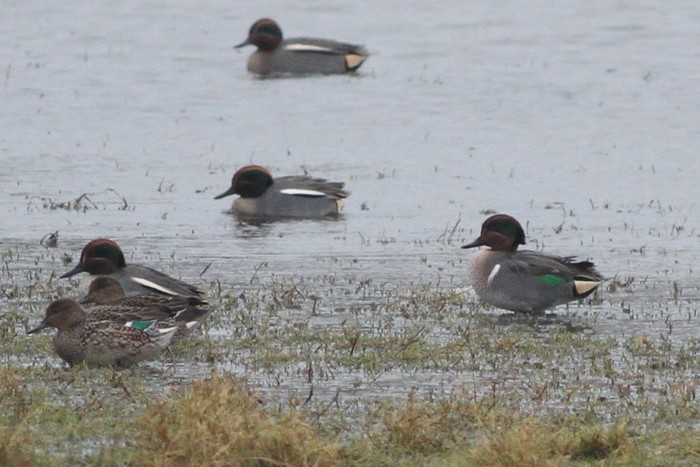
Further Celtic birds were seen at Maer Lake CBWPS (Cornwall) on 15th-21st, Caerlaverock WWT (Dumfries & Galloway) and Loch a’Phuill, Tiree (Argyll & Bute) throughout the week and Termoncarragh Lough from 17th, with further birds noted as still present at North Cave Wetlands (East Yorkshire) to 17th and Sopley, Christchurch Harbour (Dorset) on 18th-21st, while new was a drake at Druridge Bay NWT (Northumberland) from 15th.
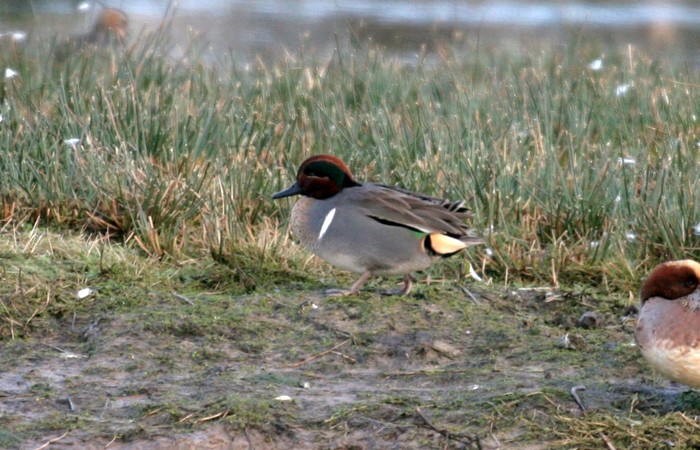
One of the week’s five drake Lesser Scaups was a new English bird ~ found at Tittesworth Reservoir (Staffordshire) on 15th where it remained until 21st. This is the fourth record for the county, and the second for the site (a one-day drake was found at Tittesworth on July 1st 2006) and follows on from the famous first for Britain found at Chasewater in March 1987.
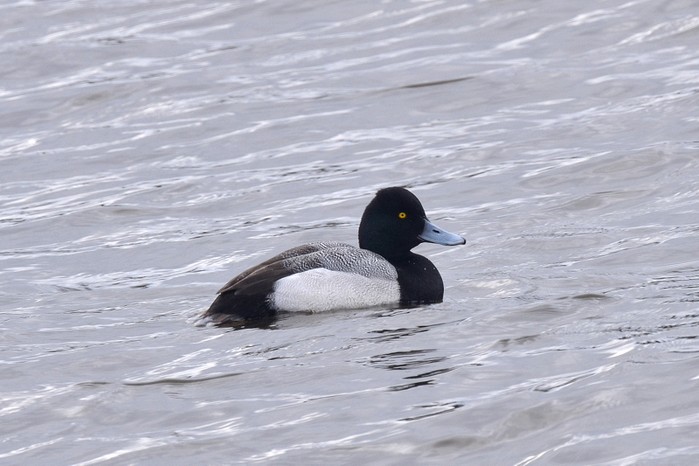
Other drakes this week remained at Loch Watten (Highland) to 18th, Dozmary Pool (Cornwall) and Cardiff Bay (Glamorgan) to 20th, when a new arrival, another drake, was found on Lough Corrib (Co. Galway). The only female remained on Loch Bee, South Uist (Outer Hebrides) to 20th.
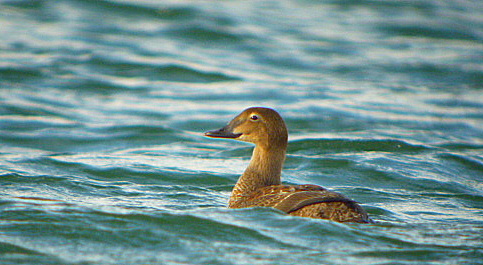
Four drake Ring-necked Ducks were recorded around Ireland through the past seven days, including two in Waterford on 18th ~ at Ballyshunnuck Reservoir and Knockaderry Lake. In Mayo, one was still at Carrowmore Lake and in Down, another remained at Castleward (both of these present to 18th at least).
In Ayrshire, a drake at Trabboch on 18th moved to Martnaham Loch on 19th and the drake was again on Meikle Loch (Aberdeenshire) on 20th. Down in southwest England, the drake stayed on Wimbleball Lake (Somerset) throughout the week and the female was on Burrator Reservoir (Devon) to 19th. The only other Aythya of note this week was the drake Ferruginous Duck was reported again from Blashford Lakes HWT (Hampshire) on 20th.
/surf_scoter_jkJan19.jpg)
The only American Wigeons reported this week were the lingering drakes at Tullaghan (Co. Leitrim/Co. Donegal), Udale Bay (Highland) and Loch of Strathbeg RSPB (Aberdeenshire) (to 16th, 18th and 20th respectively).
The week began with the drake King Eider still in place at Nairn (Highland) and was followed by a female off Ruddons Point (Fife) on 16th (the first in the county since 2008) when the female was also noted as being still in place in Blacksod Bay (Co. Mayo). The week’s third female was noted again off the coast of Lothian, at Fidra, on 18th with a (remarkable) fourth found in Cork, at West Beara, Cahermore on 19th ~ potentially the first record in the county since a drake was seen at Baltimore in January and February 1959 (that being the only county record to date).
Up to five Surf Scoters (four drakes and a duck) have been noted off Pensarn (Conwy) through the past few days, with presumably one of the same drakes also appearing not far away, off Llandulas on 19th. A single drake remained off Musselburgh (Lothian) to the same date and a first-winter drake was again at Carron Point (Co. Antrim) on 18th. Lone females were still at Seven Heads (Co. Cork) on 16th and off Peninerine, South Uist (Outer Hebrides) on 18th-20th and the latter date saw the Poole harbour youngster being noted again.
Black-winged Stilt is a species that you’d never associated with the middle of January (just as though you’d never associated Marsh Sandpiper with the depths of a British winter either) but the past few months have been full-to-the-brim with surprises so the startling Saturday afternoon news of the arrival of bubble-gum pink lanky-legged Himantopus was to be taken fully in the collective stride.
The venue for this (at first glance) remarkable occurrence was Blunham (Bedfordshire) ~ most notable for some of us as the place that saw the empty box marked “Collared Pratincole” nicely inked in during May 1983 ~ and could have become just the third January arrival for this popular species if it hadn’t been in possession of a neat red ring…
But while we’re passing Archive Corner, here’s the news for the other two ~ sometime around January 1836, a Black-winged Stilt was shot near Ballinrobe (Co. Mayo) while the only other to be found during the month appeared on St. Mary’s (Scilly) on January 12th 1951 (it stayed there until 16th, relocating to Tresco on February 7th).
Despite the excrutiating scarcity in January, many of us will have seen one in the first month of the year...”Sammy” the resident Black-winged Stilt that spent almost 12 years at Titchwell (where did it come from?) between August 1993 and May 2005 was a regular feature on the yearlisting circuit and was one of the most viewed rarities in British birding history.
No such “origin” worries for the Spotted Sandpiper found at Sruhill Lough, Achill Island (Co. Mayo) on 19th ~ the first record of the species for six months and only the third record for the county too. The first came as recently as 2010 (seen at Leam Lough, on the Mullet in September of that year) with the second following on the year after in 2011, found at the same spot as this week’s newbie.
On the Outer Hebrides, the remarkable wintering Marsh Sandpiper was still at Rubh’ Arnal, North Uist to 19th with the Lesser Yellowlegs at Lepe CP (Hampshire) present to the same date to be followed by the reappearance, in the same county, of the Long-billed Dowitcher back again at Pennington Marshes on 20th in what has been a busier week than of late for all things shorebird.
Ireland’s first Laughing Gull since a one-day summer adult in Mayo in June 2008 was found at Ballycotton on 18th ~ a first-winter present around the harbour throughout the day (and the following day too and on to 21st), becoming the 15th county record to boot.
The first was found at Tivoli in August 1968 with a further 16 years elapsing until the next, a five-day first-winter at Cobh in January 1984. One more followed during the 80’s, at The Lough in October 1988, while two appered in the 1990’s ~ again at The Lough from January 1995 and at the fantastic City Dump in Cork itself in early January 1998.
Nine more records came between 2004 and 2007, with four in 2005 and three in 2006 with the most recent coming at Inchydoney in July 2007.
Rarer still, certainly in real terms, was the newly-arrived first-winter Forster’s Tern found in Elly Bay, on the Mullet Peninsula in County Mayo, on 16th and which was still present there on 20h.
Only the third record for the “Plain of the Yew Tree” county, it is also the third record for the Mullet. The first, an adult, appeared on February 1st 1989 before relocating to Killala Bay later the same month while the second, another first-winter, was also discovered in Elly Bay in November 2002, where it lingered to the middle of February ’03.
The stats show just under 100 accepted records of this delightful species but with much duplication of returning and roaming birds in the Irish Republic over the past 15 years or so, the number is considerably lower. First-winters have been desperately rare too in recent years, a brief visitor at Lady’s Island Lake and Carne Harbour in Wexford this time last year was the first young bird noted for seven years.
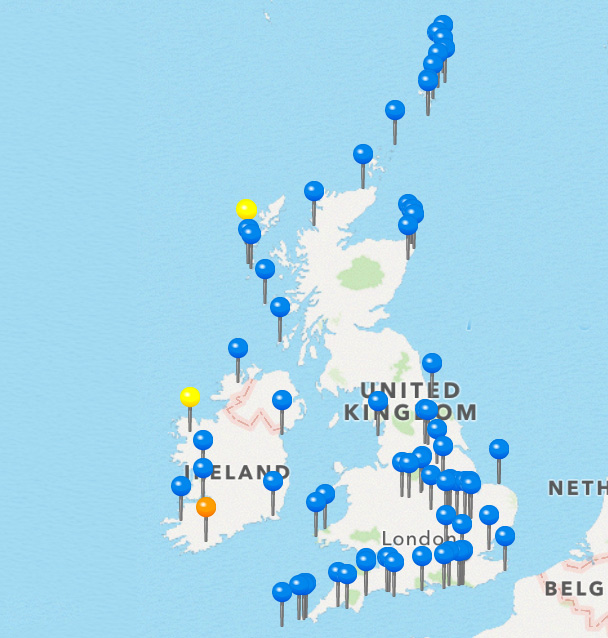
using our smartphone app BirdAlertPRO - try it for free here
More revealing still is the stat that shows a whopping 10 Irish counties (Cork, ‘Derry, Down, Dublin, Galway, Louth, Mayo, Sligo, Waterford and Wexford) have recorded the species in the time that has elapsed since the last British record ~ a four-day bird in Oban Bay (Argyll) in January 2003 ~ with the most recent accesible mainland bird coming the year before that, on Cornwall’s Hayle Estuary in November and December 2002.
A gap of almost 12 years and, again for those with a listing disposition that doesn’t include Ireland, there will be much gazing at their pagers and smartphones waiting for the next Forster’s to drop. There may be quite a crowd when it does….
In Devon, the wintering adult Bonaparte’s Gull remained around the Dawlish Warren area for another week.
As the weekend drew to a close, around 100 Glaucous Gull had been recorded across Britain and Ireland ~ with a minimum 15 in County Mayo at just two sites the standout, eight were in Blacksod Bay on the Mullet Peninsula on 17th and a further seven (five adults and two juveniles) were on Achill Island on 18th. Another seven or more were recorded at Ballycotton in a gull-filled harbour on 19th. Four juveniles were at Killybegs (Co. Donegal) on 16th and three more were on Inishbofin (Co. Galway) on 20th and these were part of an Irish tally of 45 or more from nine counties.
On South Uist at least seven birds were at Kildonan on 17th with three more at Paible through the week with another two on North Uist. Shetland saw three together in Lerwick while Aberdeenshire and Argyll & Bute both had three a piece while at Newgale (Pembrokeshire), four birds (an adult and three juveniles) were seen on the beach on 15th. Up to 10 were noted around the Midlands, with another eight in the southwest, including four in Cornwall.
/glaucous_gull_rubh_arnal2014c.jpg)
Iceland Gulls again trailed a little way behind their beefier cousins, around 75 logged as the week drew to a close. Four of Scotland’s eleven birds were seen in the harbour at Stornoway, Lewis (Outer Hebrides), while there were three for both Richmond Bank and Sandbach Flashes (Cheshire) on 18th. Two were logged at Newgale in west Wales, while the Midlands saw around a dozen birds noted including three in Leicestershire.
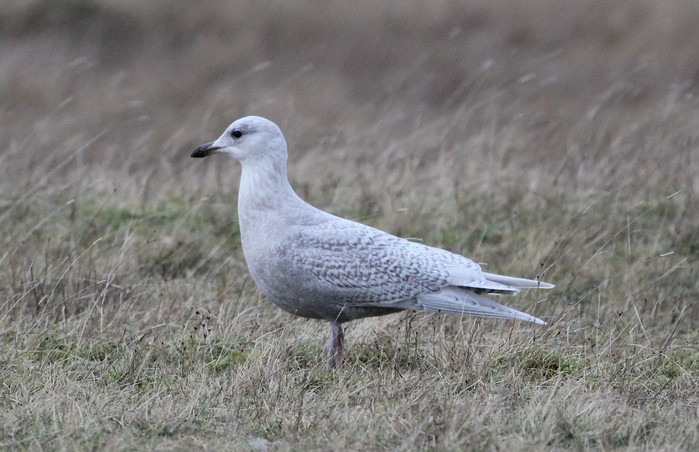
Irish gullers located some 20 or so through the week, from at least seven counties, with up to six in Kerry and three in Mayo.
It was another week where Kumlien’s Gulls wracked up double figures, up to 18 birds logged with seven of those seen in County Kerry. On 15th, a juvenile and an adult were seen at Rossbeigh, a juvenile was seen at Dingle on 18th and another young bird was at Inch on 19th, with three there the next day. The final Kerry Kumlien’s was found at Reenard Point on 21st. Further Irish birds, two of them birds-of-the-year, were at Wexford on 18th and on Keel Golf Course, Achill Island (Co. Mayo) on the same date. The 19th saw the appearance of another young bird at Lahinch (Co. Clare) while an adult was seen at Helvick Head (Co. Waterford) on 20th.
Two juvenile Kumlien’s were seen in the roost at Llys-y-fran Reservoir (Pembrokeshire) on 19th with last week’s adult lingering at Newgale to 17th at least. Two more juveniles were at Thurso (Highland) on 20th and the final two birds this week were both seen in Yorkshire gull roosts ~ a juvenile at Angler’s Country Park (West Yorkshire) on 16th and an adult at Broomhead Reservoir (South Yorkshire) on 18th-19th.

Ten Irish counties hosted 22 Ring-billed Gulls this week, with up to 10 in County Cork (including two near Youghal on 18th, two at Ballycotton on 19th and two at Blackrock on 20th) and three at Galway’s Nimmo’s Pier (two adults and a first-winter recorded over the past seven days). A new first-winter was found on the very productive surrounds of Keel Golf Course on Achill Island in Mayo on 18th while single adults were seen in Antrim, Derry, Dublin, Limerick, Waterford, Wicklow and Wexford.
Two single Ring-billed Gulls were seen in and around Merseyside, the adult again at Crosby on 16th and 21st, and the second-winter still in Walton on 19th with two for Pembrokeshire as well ~ the second-winter still at Newgale on 15th and the adult again in the roost at Llys-y-Fran on 17th and 19th.
Further adults were at Millbrook, Torpoint (Cornwall) on 18th and, as usual, at Gosport (Hampshire) and Dingwall (Highland) through the week but new was an adult in Buckinghamshire, at Little Marlow GPs on 20th (possibly the first county record since one at the same site in April 2005). Whether this was then the bird that appeared in the roost at Queen Mother Reservoir (Berkshire) later the same day isn’t known ~ it would be a heck of a coincidence to chance upon it but it would also be pretty wild to have two Ringos in the same general area of the country too…
Finally, news of a near-adult Azorean Yellow-legged Gull in the harbour at Wexford ~ first seen on 17th, the bird remained there to 21st.

A white Gyrfalcon was seen snaffling a Curlew near Fenit (Co. Kerry) on 18th while all bar one of the eight Rough-legged Buzzards reported this week were seen in East Anglia ~ the odd-one-out was seen near Martin (Hampshire) on 15th. Three birds were in Norfolk, two lingering at the Waveney Forest for much of the week and a juvenile was on the north coast, at Burnham Overy Staithe and Holkham on 19th-20th. A single bird was still in Suffolk, at Orford Ness, on 18th and further singles further south were seen at Foulness and Wallasea islands in Essex on 15th and 18th with the final bird being reported in Cambridgeshire, at Needingworth Quarry, on 19th.
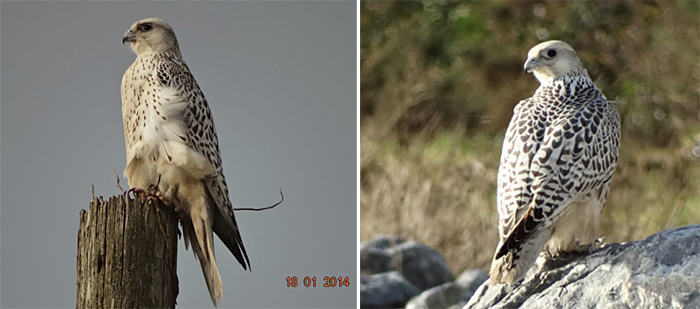
Kent’s two Hume’s Yellow-browed Warblers remained for a few more days this week ~ the bird at Ramsgate Cemetery remained to 20th, the bird at Dungeness present to 21st.
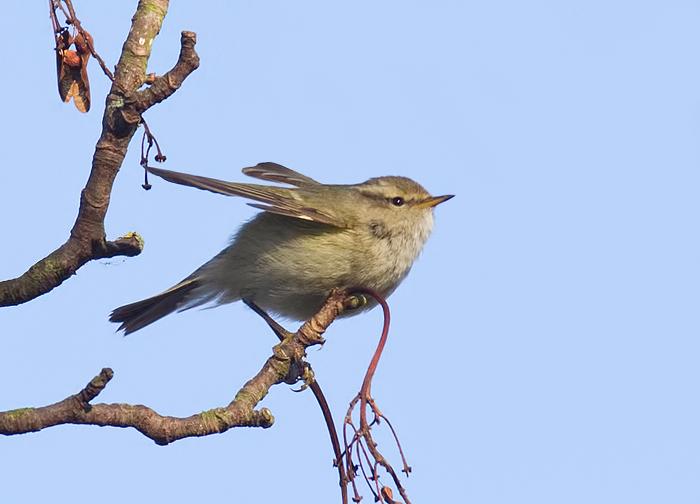
All five Yellow-browed Warblers this week were in the southwest again ~ three at Torpoint (Cornwall) on 17th were joined by singles still at Clennon Valley Lakes (Devon) and Sutton Bingham (Somerset), both present across the weekend.
Wintering potential “eastern” Lesser Whitethroats remained on the edge of Prior’s Park (Northumberland) through much of the week as well as a garden in Northampton. A third bird thought to be of interesting origins was seen at Tetney (Lincolnshire) on 15th ~ having been present for a month or more. Further winters were seen in Cornwall, the Isle of Wight, Nottinghamshire and Derbyshire.
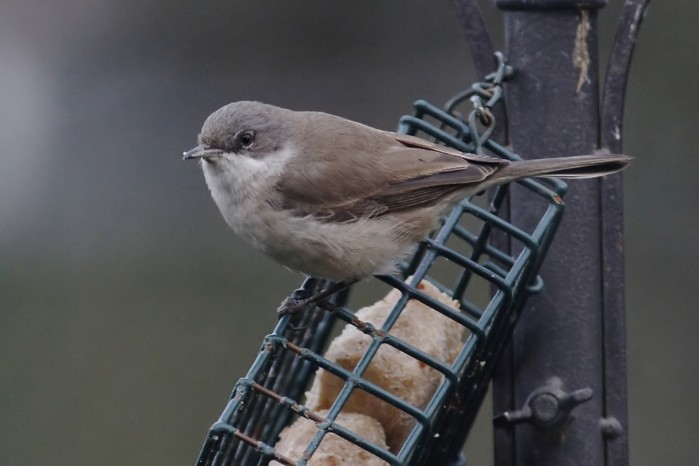
Great Grey Shrike numbers pretty much mirrored those of last week, perhaps up a touch ~ with a slight shuffle of the pack too ~ 23 birds in 17 counties this time around with three in Gloucestershire through the past few days along with three reported from different New Forest sites across the weekend as well. Six or seven birds were seen across the Midlands, from Staffordshire to Worcestershire, three were logged in the northeast and there were three seen in Wales (two in Powys and one in Gwent).
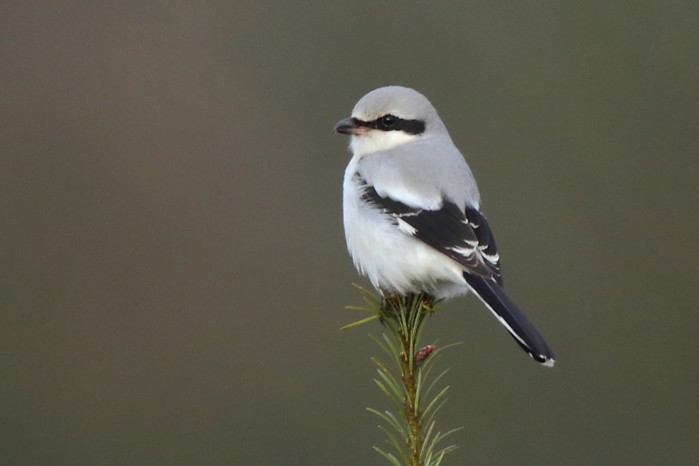
On the Lizard, at Caerthillian, the Richard’s Pipit remained to 18th while on Scilly, the first-winter Rose-coloured Starling continued to enjoy life around the allotments on St. Mary’s present for another week. In Kent, a Hoopoe was reported from Snodland on 18th, but there was no further sign later that day.
In County Durham, a possible Black-bellied Dipper was at Castle Eden Dene NNR on 18th-19th (having been in the area since November 2013) and somewhere near Chester, an Arctic Redpoll was identified from photographs of garden feeder birds, seen recently but with no further news as to whether it is still present. It certainly looks a snorter in the online images posted so far…
A minimum 38 Parrot Crossbills were recorded in six English counties this week ~ leading the way still, the 14 strong group at Budby Common (Nottinghamshire), present there to 19th at least. In East Sussex, 10 remained in the Ashdown Forest and in Norfolk, at least eight were still around the edge of Holt Country Park to the end of the weekend. Two birds were again at Mayday Farm (Suffolk) on 17th and a singing male was one of two birds seen at Bolderwood (Hampshire) on 19th. Single big-billed-birds remained at Waveney Forest (Norfolk) and Hemsted (Kent) ~ to 16th and 17th respectively.
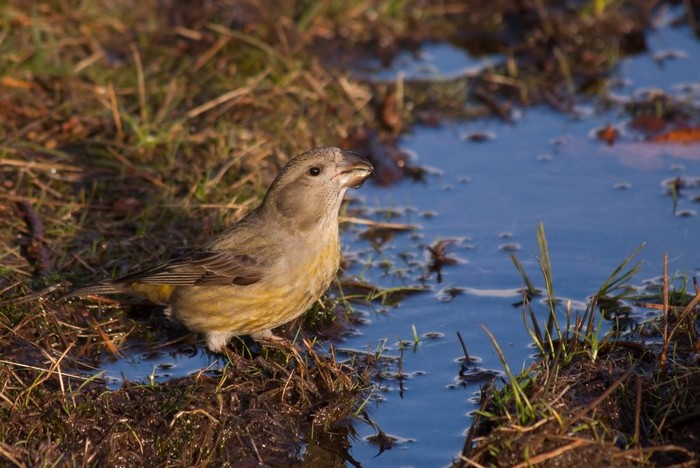
The mobile flock of at least 15 Two-barred Crossbills continued to move along the Serridge Ridge (Gloucestershire) to 20th (with 11 there, including eight males on 21st) and seven (including five males) remained at Broomhead Reservoir (South Yorkshire) throughout the week, and two males and a female were still being seen in the Wyre Forest (Shropshire) to 20th.
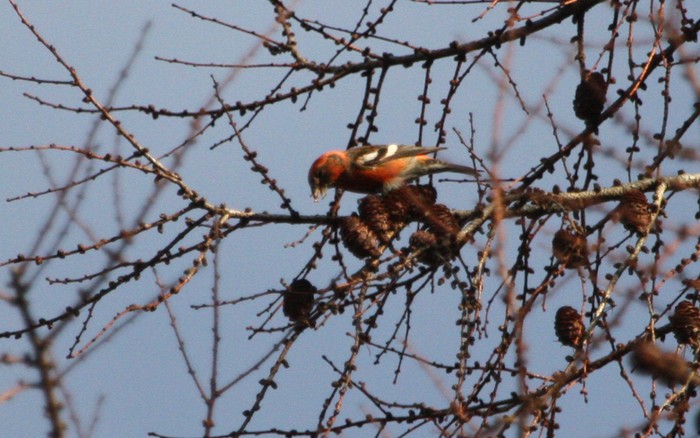
Another miserly tally for Waxwings this week ~ less than 45 seen countrywide, with the 15 in Jarrow (Co. Durham) the only double figure group recorded. Only 14 birds were seen across Scotland, while there were four birds each for Blackburn (Lancashire) and Norwich (Norfolk). Slim pickings indeed…
January is already beginning to draw to a close, but it has been full-to-the-brim with quality birds already. There’s not much of a change on the horizon in the weather though there’s a hint that winds may swing to the European continent rather than the Americas.
Birders in the Netherlands are still awash with an even better selection of outstanding birds than we are ~ a Brown Shrike near the German border was their latest big bird this weekend, but there’s one date on the upcoming calendar that stands out ~ January 24th.
That has brought us the discovery of a freshly dead American Purple Gallinule in the middle of Devon in 2011 while in the middle of Kent, in 1989 came the marvellous Golden-winged Warbler.
Those two species seem highly unlikely to repat themselves but if some easterlies do pick up and drop something new around our shores, maybe a Pine Bunting or a nice, rare thrush could be what sets the pulses racing next.
Failing that and if the westerlies pick up again (as the latest forecast seems to indicate), you could do a lot worse than pack your bags and go birding along the fabulous Irish west coast ~ it feels as though there’s a still a stack of great gulls to be uncovered, while the haul on Mayo’s Mullet and Achill is worthy of a trip in itself...
Mark Golley
22 January 2013
Many thanks to this week's contributors for their photos and videos


